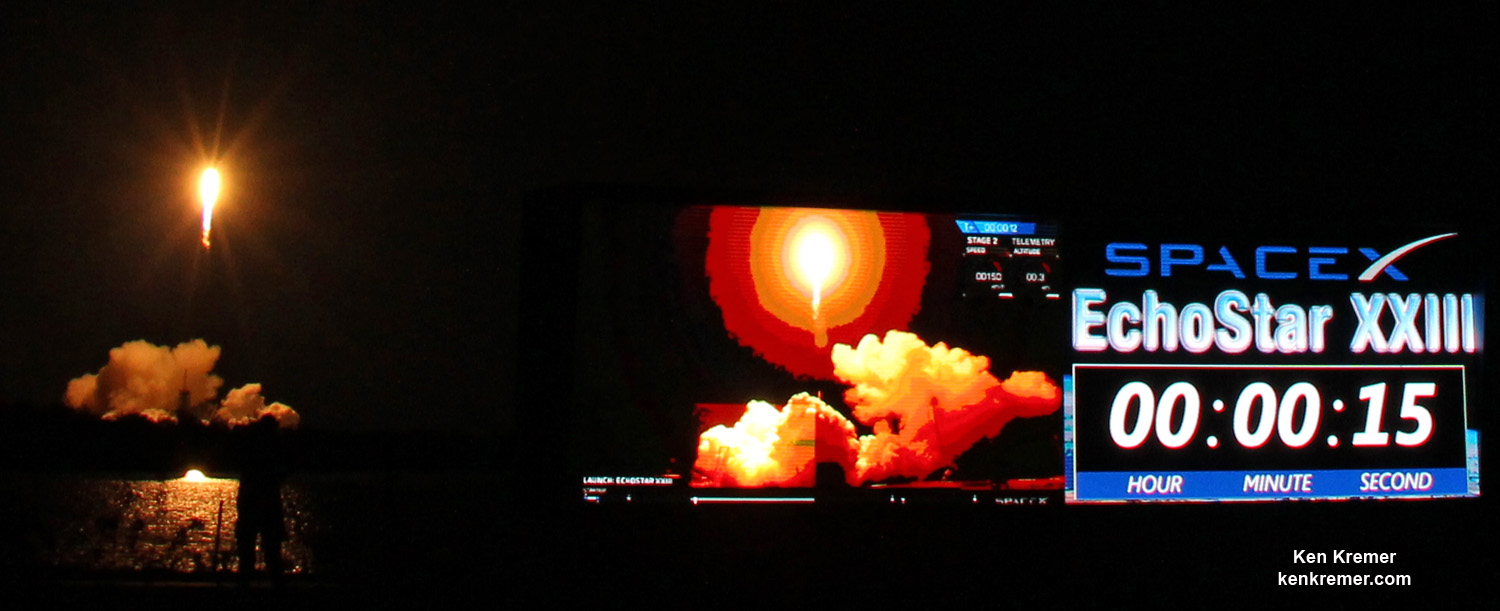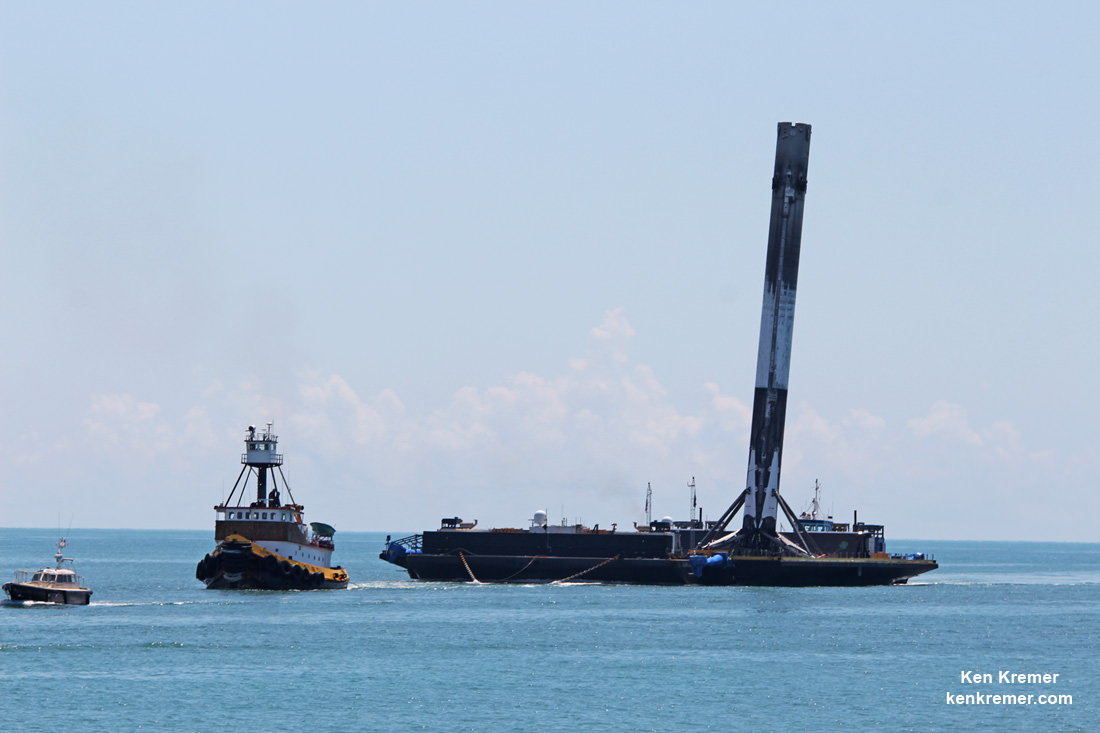
SPACE VIEW PARK/KENNEDY SPACE CENTER, FL – This afternoons (Mar. 27) successful hotfire test of a recycled Falcon 9 booster at the Kennedy Space Center sets SpaceX on course for a rendezvous with history involving the first ever relaunch of a ‘Flight-Proven’ rocket later this week.
The milestone mission to refly the first ever ‘used rocket’ is slated for lift off on Thursday, March 30, at 6 p.m. EDT from seaside Launch Complex 39A at NASA’s Kennedy Space Center in Florida, carrying the SES-10 telecommunications payload.
“Static fire test complete,” SpaceX confirmed via social media.
“Targeting Thursday, March 30 for Falcon 9 launch of SES-10.”
SES-10 is to be the first satellite launching on a SpaceX flight-proven rocket, gushes telecommunications giant SES.
The flight proven SpaceX Falcon 9 rocket will deliver SES-10 to a Geostationary Transfer Orbit (GTO).
The Falcon 9 booster to be recycled was initially launched in April 2016 for NASA on the SpaceX Dragon CRS-8 resupply mission to the International Space Station (ISS) under contract for the space agency.
The Falcon 9 first stage was recovered about 8 and a half minutes after liftoff via a propulsive soft landing on an ocean going droneship in the Atlantic Ocean some 400 miles (600 km) off the US East coast.
The brief engine test lasting approximately three seconds took place at 2 p.m. today, Monday March 27, with the sudden eruption of smoke and ash rushing into the air over historic pad 39A on NASA’s Kennedy Space Center during a picture perfect sunny afternoon – as I witnessed from Space View Park in Titusville, FL.
During today’s static fire test, the rocket’s first and second stages are fueled with liquid oxygen and RP-1 propellants like an actual launch, and a simulated countdown is carried out to the point of a brief engine ignition.
The hold down engine test with the erected rocket involved the ignition of all nine Merlin 1D first stage engines generating some 1.7 million pounds of thrust at pad 39A while the two stage rocket was restrained on the pad.
This is only the third Falcon 9 static fire test ever conducted on Pad 39A.
Pad 39A has been repurposed by SpaceX from its days as a NASA shuttle launch pad.
Watch this video of the March 27 static fire test from colleague Jeff Seibert:
Video Caption: SpaceX Falcon 9 hot fire test on March 27, 2017 for SES-10 launch on March 30 on KSC Pad 39A. Credit: Jeff Seibert
Space View Park is a great place to watch rocket launches from as it offers an unobstructed view across the inland river to the Kennedy Space Center and Cape Canaveral Air Force Station launch pads dotting the Florida Space Coast.
SpaceX, founded by billionaire and CEO Elon Musk, inked a deal in August 2016 with telecommunications giant SES, to refly a ‘Flight-Proven’ Falcon 9 booster.
Luxembourg-based SES and Hawthrone, CA-based SpaceX jointly announced the agreement to “launch SES-10 on a flight-proven Falcon 9 orbital rocket booster.”
Exactly how much money SES will save by utilizing a recycled rocket is not known. But SpaceX officials have been quoted as saying the savings could be between 10 to 30 percent.
This critical engine test opens the door to what will be only the third blastoff of the SpaceX commercial Falcon 9 rocket from seaside Launch Complex 39A at NASA’s Kennedy Space Center in Florida.
So SpaceX is definitely picking up the pace of launch operations as this blastoff comes barely 2 weeks after the prior launch on March 16 with EchoStar XXIII.

Liftoff of the Falcon 9 carrying the SES-10 telecommunications satellite is now slated for 6 p.m. EDT at the opening of the launch window
The two and a half hour launch window closes at 8:30 p.m. EDT.
SES-10 will replace AMC-3 and AMC-4 to provide enhanced coverage and significant capacity expansion over Latin America, says SES.
“The satellite will be positioned at 67 degrees West, pursuant to an agreement with the Andean Community (Bolivia, Colombia, Ecuador and Peru), and will be used for the Simón Bolivar 2 satellite network.”

Stay tuned here for Ken’s continuing Earth and Planetary science and human spaceflight news.
………….
Learn more about SpaceX SES-10, EchoStar 23 and CRS-10 launches to ISS, ULA SBIRS GEO 3 launch, GOES-R launch, Heroes and Legends at KSCVC, OSIRIS-REx, InSight Mars lander, Juno at Jupiter, SpaceX AMOS-6, ISS, ULA Atlas and Delta rockets, Orbital ATK Cygnus, Boeing, Space Taxis, Mars rovers, Orion, SLS, Antares, NASA missions and more at Ken’s upcoming outreach events at Kennedy Space Center Quality Inn, Titusville, FL:
Mar 29/31, Apr 1: “SpaceX SES-10, EchoStar 23, CRS-10 launch to ISS, ULA Atlas SBIRS GEO 3 launch, GOES-R weather satellite launch, OSIRIS-Rex, SpaceX and Orbital ATK missions to the ISS, Juno at Jupiter, ULA Delta 4 Heavy spy satellite, SLS, Orion, Commercial crew, Curiosity explores Mars, Pluto and more,” Kennedy Space Center Quality Inn, Titusville, FL, evenings


“This critical engine test opens the door to what will be only the third second blastoff of the SpaceX commercial Falcon 9 rocket from seaside Launch Complex 39A at NASA’s Kennedy Space Center in Florida.”
When will the second third blastoff be?
Will this booster land on a barge and be reused again?
They’ll try and land it, but it won’t be reused again. The reason is that these are Falcon 9 Block 3 vehicles, and they’re only good for 1 or 2 reuses, and only then with moderate refurbishment. Block was only manufactured in very small numbers, and hasn’t yet flown yet. Block 5, due to fly for the first time at the end of 2017 or early 2018, is suppose to be good for 10+ reuses with minimal refurbishment. Those are the cores that you’ll see being reused over and over again. The older (current) Block 3 cores will all be rapidly retired once Block 5 enters service.
That should have said “Block 4 was only manufactured in very small numbers…”